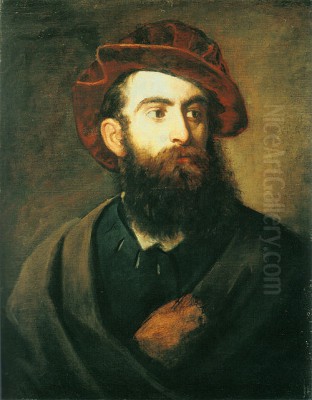
Hans Makart stands as a towering figure in 19th-century Austrian art. Born on May 28, 1840, in the picturesque city of Salzburg, and passing away relatively young on October 3, 1884, in Vienna, Makart was more than just a painter. He was a highly influential designer, decorator, and a central personality in the cultural life of the Austro-Hungarian Empire during the vibrant Ringstrasse era. His name became synonymous with a particular style, the "Makartstil," which captured the opulent and theatrical spirit of the age.
As an artist primarily associated with academic history painting, Makart's work is celebrated for its dazzling use of color, dynamic and often daring compositions, and an undeniable sense of drama. His influence permeated Viennese society and extended across Europe, leaving an indelible mark on the visual culture of his time and inspiring future generations of artists, most notably Gustav Klimt.
Early Life and Artistic Formation
Hans Makart's journey into the art world began in Salzburg, where he was born within the walls of the Mirabell Palace. His father served as a chamberlain at the palace, providing a connection, albeit modest, to the aristocratic world that would later embrace him. His mother was Maria Theresia Karminefska. This early exposure to the grandeur of palatial life may have subtly influenced his later artistic inclinations towards splendor and spectacle.
In 1858, the young Makart moved to Vienna, the imperial capital, to pursue formal art training at the prestigious Academy of Fine Arts. However, his initial experience there was far from successful. The rigid academic methods did not suit his temperament, and according to some accounts, he was deemed lacking in talent and encouraged to leave. This early setback did not deter him.
Undiscouraged, Makart sought further training in Munich, a major artistic center rivaling Vienna at the time. From 1860 to 1865, he studied at the Munich Academy under the guidance of Karl Theodor von Piloty. Piloty was a renowned history painter, considered an innovator in the German historical genre, known for his realistic detail and dramatic flair. Under Piloty's tutelage, Makart honed his skills and began to develop his own distinctive, color-centric style.
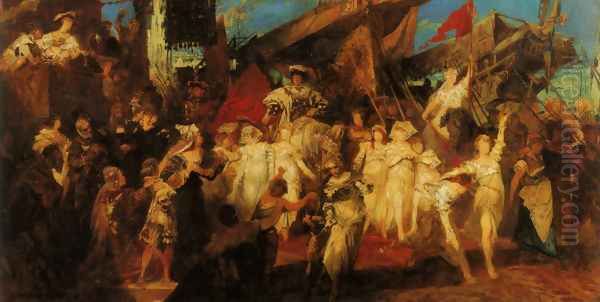
His artistic education was further enriched by travels. Makart visited London, Paris, and Rome, exposing himself to the masterpieces of European art history and the contemporary art scenes of these capitals. These journeys broadened his horizons and undoubtedly contributed to the eclectic yet unified vision that would characterize his mature work. He absorbed influences from the Venetian masters like Titian and Veronese, and the Baroque energy of Peter Paul Rubens.
Rise to Prominence in Vienna
Makart's breakthrough came relatively early. His participation in the Paris World Exposition of 1867 brought him significant attention. He exhibited large-scale, sensational canvases like the triptych Modern Amoretti and the dramatic The Plague in Florence. These works, with their bold sensuality and historical themes rendered with theatrical intensity, captivated audiences and critics alike, establishing his reputation on an international stage.
This success caught the eye of the Austrian establishment. In 1869, Emperor Franz Joseph I himself extended an invitation for Makart to return to Vienna. The Emperor granted him a large state-funded studio, a clear signal of imperial favor and high expectations. This marked the beginning of Makart's reign as the unofficial "prince of painters" in Vienna.
Settling back in the imperial capital, Makart quickly became a dominant force. In 1872, he established his legendary studio at Gußhausstraße 25. This was no ordinary workspace; Makart transformed it into a lavishly decorated environment, filled with antiques, luxurious fabrics, plants, and artistic props. It became one of the most important social centers in Vienna, a place where the city's aristocracy, political figures, fellow artists, writers, and international celebrities gathered.
His career continued its ascent. He received numerous commissions for large historical paintings and decorative projects. In 1876, his status was further solidified when he was appointed a professor at the Vienna Academy of Fine Arts – the very institution that had once dismissed him.
The Makartstil: Defining an Era
Hans Makart's unique artistic approach became so influential that it earned its own designation: the "Makartstil" or Makart Style. This style represented a culmination of various influences, blending the grandeur of the Baroque, the emotional intensity of Romanticism, and the detailed richness of Historicism, all filtered through Makart's distinctive sensibility.
The defining characteristic of the Makartstil was its emphasis on opulent visual effects. Makart was often called a "magician of color" (Farbzauberer). He employed a rich, vibrant palette, often using dramatic contrasts of light and shadow (chiaroscuro) to heighten the theatricality of his scenes. His compositions were typically complex, filled with figures, elaborate costumes, and decorative details, creating a sense of overwhelming abundance and sensory richness.
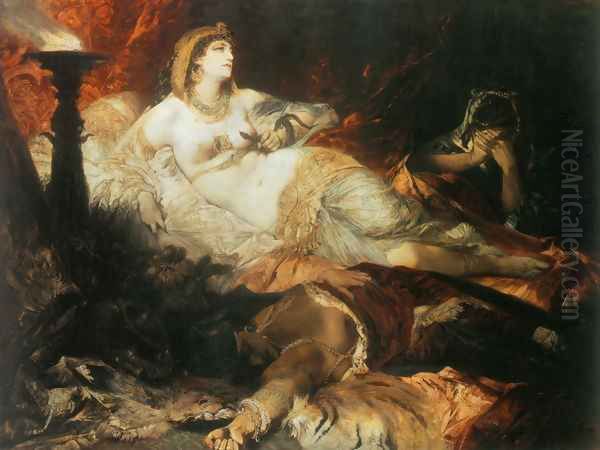
While rooted in the academic tradition of history painting, Makart's interpretation was less concerned with historical accuracy than with creating a powerful aesthetic impact. He treated historical and mythological subjects as stages for exploring themes of life, death, passion, and beauty, often imbuing them with a palpable sensuality that sometimes bordered on the provocative.
The Makartstil was not confined to painting. It extended to interior design, furniture, fashion, and the decorative arts. Makart himself was actively involved in designing interiors for Viennese high society, and his aesthetic preferences heavily influenced the design of public buildings along the newly constructed Ringstrasse, Vienna's grand circular boulevard. The style became synonymous with the luxurious tastes of the Viennese elite during the late 19th century.
Major Works and Themes
Makart's oeuvre is dominated by large-scale history paintings, allegories, and mythological scenes, alongside striking portraits. Several works stand out as particularly representative of his style and impact.
Modern Amoretti (Moderne Amoretten), the triptych that helped launch his fame in Paris, depicts playful, semi-nude figures against vibrant backgrounds, showcasing his early mastery of color and sensual form.
The Plague in Florence (Die Pest in Florenz), another early success, is a dramatic and somewhat morbid portrayal of Boccaccio's Decameron, filled with languid figures amidst death and decay, rendered with rich textures and a charged atmosphere.
The Entry of Charles V into Antwerp (Einzug Karls V. in Antwerpen) is one of his most famous and controversial works. This massive canvas depicts the historical event with immense pomp and circumstance, but its inclusion of numerous nude female figures welcoming the Emperor caused a scandal, particularly in the United States where it was targeted by moral crusaders like Anthony Comstock. This controversy, however, only amplified Makart's fame.
The Death of Cleopatra (Der Tod der Kleopatra), housed today in Kassel, Germany, treats the famous historical suicide with characteristic theatricality, focusing on the beauty and tragedy of the Egyptian queen against a backdrop suggestive of ancient splendor.
The Five Senses (Die Fünf Sinne) is a cycle of five allegorical paintings (Sight, Hearing, Smell, Taste, Touch), personified by voluptuous female figures surrounded by attributes related to each sense. These works, now in the Österreichische Galerie Belvedere in Vienna, exemplify his decorative approach and sensual portrayal of the human form.

Abundantia: The Gifts of the Earth and The Gifts of the Sea are allegorical works celebrating nature's bounty, filled with lush details and dynamic figures, showcasing his decorative talents. One version, The Treasures of the Sea, is held by the Art Institute of Chicago.
Romeo and Juliet (Romeo und Julia), purchased by the Vienna Museum, demonstrates his ability to tackle literary themes with emotional intensity and visual richness.
These works, among many others, cemented Makart's reputation as a master storyteller on canvas, capable of creating immersive, visually stunning worlds that captivated the public imagination. His themes often revolved around moments of high drama, historical pageantry, or allegorical representations of abstract concepts, always rendered with his signature flair.
The Artist as Designer and Decorator
Makart's influence extended far beyond the easel. He embraced the concept of the Gesamtkunstwerk (total work of art), seeking to integrate art into all aspects of life. His own studio was a prime example, meticulously curated to create a specific atmosphere. This interest naturally led him into the fields of interior design and decoration.
He received commissions to design entire rooms for wealthy patrons and public buildings. His style, characterized by heavy draperies, dark woods, plush upholstery, abundant ornamentation, and the prominent display of art objects and historical artifacts, became the height of fashion for Viennese interiors during the 1870s and 1880s. The "Makart Style" interior was a symbol of status and sophisticated taste.
Makart also designed furniture, costumes for theatrical productions, and even festive decorations for public events. His designs often incorporated historical motifs, exotic elements, and a sense of theatricality, mirroring the qualities found in his paintings. This holistic approach to design significantly shaped the aesthetic landscape of Vienna's Ringstrasse era.
The Studio as Social Epicenter
Makart's studio on Gußhausstraße was more than just a place of work; it was the epicenter of Viennese cultural and social life. Makart cultivated an image as an artist-prince, and his studio parties were legendary events, attracting the highest echelons of society. Royalty, aristocrats, politicians, financiers, fellow artists like Franz von Lenbach, writers, musicians, and international visitors flocked to his lavishly decorated space.
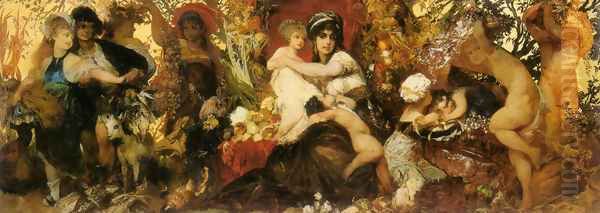
These gatherings were not merely social occasions; they were carefully orchestrated performances that enhanced Makart's mystique and influence. The studio itself, filled with art, antiques, and exotic objects, served as a living embodiment of his aesthetic vision. It functioned as a stage where Makart could present himself and his art, blurring the lines between life and artistic creation.
The photographer Carl Rudolf Huber, a friend of Makart's, captured glimpses of this world, photographing the artist and his circle in relaxed, sometimes staged, moments within the studio environment. These photographs provide valuable documentation of Makart's social milieu and the unique atmosphere he cultivated. His ability to navigate and dominate the social scene was integral to his success and the widespread adoption of the "Makartstil."
Public Spectacle: The Makart Parade
Perhaps the most spectacular manifestation of Makart's public influence was the grand procession he organized in 1879 to celebrate the silver wedding anniversary of Emperor Franz Joseph I and Empress Elisabeth (Sisi). Known as the "Makart-Festzug" (Makart Procession or Makart Parade), this event was a massive historical pageant that wound its way through the streets of Vienna.
Makart designed the entire spectacle, including elaborate costumes, floats, and historical groupings representing different guilds and periods from Vienna's history. Thousands of citizens participated, dressed in costumes designed or approved by Makart. The parade was an unprecedented public celebration, a living history painting brought to life, showcasing Makart's organizational skills and his deep connection to the city's cultural identity.
The event was a resounding success in terms of public enthusiasm and cementing Makart's status as a cultural icon. However, it also drew criticism for its immense cost and perceived extravagance, reflecting the tensions within Viennese society between imperial display and emerging social concerns. Nevertheless, the Makart Parade remains a landmark event in Viennese history, demonstrating the artist's unique ability to command the public stage.
Contemporaries, Rivals, and Influences
Makart did not operate in a vacuum. He was part of a vibrant European art scene and interacted with numerous contemporaries. His teacher, Karl Theodor von Piloty, provided a crucial foundation in Munich. Makart, in turn, absorbed lessons from the great colorists of the past, particularly Venetian Renaissance painters like Titian and Veronese, and Baroque masters like Peter Paul Rubens, whose dynamism and sensuality clearly resonated with him.
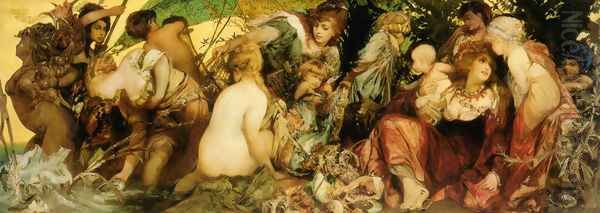
In Vienna, he was the undisputed star, but he had contemporaries and rivals. Hans Canon was another prominent history painter in Vienna, often seen as a competitor, though Makart's fame largely eclipsed him. The sculptor Viktor Tilgner was also a major figure in the Viennese art world of the time. Other significant Viennese painters of the era included Carl Rahl and Anselm Feuerbach, who also contributed to the decoration of Ringstrasse buildings.
Makart maintained connections with artists beyond Vienna. He was friends with the influential German portraitist Franz von Lenbach from his Munich days. His work can be compared to other European academic painters who specialized in historical and exotic scenes, such as the French painter Jean-Léon Gérôme or the Dutch-born British artist Lawrence Alma-Tadema, although Makart's style remained distinctly Viennese. He was also considered the Austrian counterpart to the Russian academic painter Karl Bryullov.
His friendship with the composer Richard Wagner is noteworthy. Both artists shared a fascination with history, mythology, and the creation of immersive, emotionally charged artistic experiences, Wagner through music drama and Makart through visual spectacle.
Makart's most significant legacy in terms of influence was on the next generation of Viennese artists, particularly Gustav Klimt. Klimt and his brother Ernst, along with Franz Matsch, formed the "Künstler-Compagnie" (Artists' Company) and initially worked in a style indebted to the historical-decorative tradition exemplified by Makart. While Klimt would later break away to forge his own revolutionary path with the Vienna Secession, the impact of Makart's emphasis on color, decoration, and sensuality remained evident in his work.
Other artists associated with the Vienna Secession, while reacting against the perceived conservatism of the establishment Makart represented, were nonetheless operating in a cultural environment profoundly shaped by his dominance. Karl Moll, a founding member of the Secession, explicitly mentioned the desire to move beyond the influence of the "Makart-led" academic establishment as a motivation for forming the new group.
Controversies and Criticisms
Despite his immense popularity, Makart was not without his critics, and his life and work were marked by controversy. His early dismissal from the Vienna Academy hinted at initial doubts about his technical proficiency, though he clearly overcame these limitations.
The most significant controversies often revolved around the perceived sensuality and moral ambiguity of his works. The depiction of nude figures in The Entry of Charles V into Antwerp caused considerable outrage, particularly among more conservative audiences and moral watchdogs like Anthony Comstock in America. This notoriety, however, paradoxically boosted his international profile.
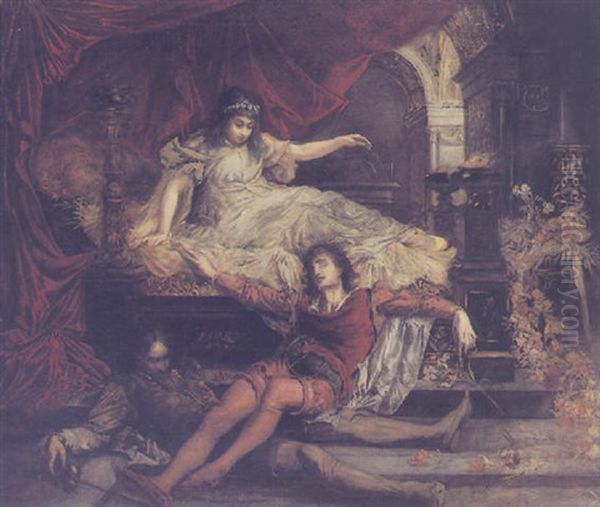
His lavish lifestyle and the extravagant nature of events like the Makart Parade also drew criticism. Some saw it as excessive and out of touch with the social realities faced by many Viennese citizens. His studio, while a center of cultural life, was also seen as a symbol of decadent luxury.
His personal life also attracted attention. His second marriage in 1883 to Bertha Babitsch, a former model, was reportedly not well-received within the upper echelons of Viennese society.
Intriguingly, decades after his death, Makart's work found an admirer in Adolf Hitler. Despite Hitler's general condemnation of modern art movements that followed Makart, he reportedly appreciated Makart's monumental style and saw him as an important, perhaps underestimated, figure in Austrian art history. This later association adds another complex layer to Makart's reception history.
Legacy and Influence
Hans Makart died prematurely in 1884 at the age of 44, reportedly from complications related to syphilis. His death marked the end of an era in Viennese art. For nearly two decades, he had been the defining artistic personality of the city, his "Makartstil" permeating painting, design, and social life.
His immediate legacy was the continuation of this opulent style for a time, but change was already in the air. The generation that followed, including Gustav Klimt, Koloman Moser, and Josef Hoffmann, would soon react against the perceived historical weight and academicism associated with Makart, leading to the formation of the Vienna Secession in 1897 and the rise of Austrian Art Nouveau (Jugendstil).
However, Makart's influence, even on those who rebelled against him, was undeniable. His bold use of color, his emphasis on decorative qualities, his integration of art and design, and his creation of immersive, total environments laid important groundwork for the innovations of the Secessionists. Klimt's own journey from historical painter to avant-garde icon shows clear traces of Makart's impact, particularly in his decorative richness and sensual themes.
Today, Makart is recognized as a key figure of European Historicism and Academic painting, but also as a unique phenomenon – an artist who not only reflected but actively shaped the cultural identity of his time and place. The term "Makartstil" remains a descriptor for the specific aesthetic of late 19th-century Vienna, a testament to his enduring impact.
Makart in Collections Today
Hans Makart's works are held in major museums and collections in Austria and internationally, allowing contemporary audiences to experience his unique vision.
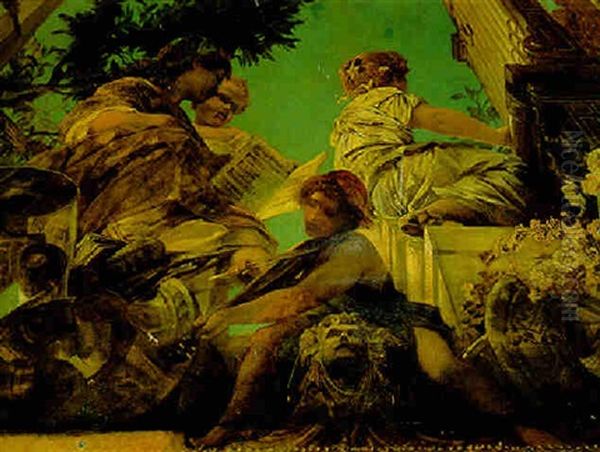
The Österreichische Galerie Belvedere in Vienna holds a significant collection, including key works like The Five Senses and The Valkyrie. The Leopold Museum, also in Vienna, frequently features Makart in exhibitions dedicated to Viennese art of the period.
In Germany, the Hamburger Kunsthalle has exhibited his monumental Entry of Charles V into Antwerp, highlighting his importance in 19th-century Salon painting. The Neue Galerie in Kassel houses his Death of Cleopatra.
Beyond Europe, the Art Institute of Chicago holds Abundantia: The Treasures of the Sea. Further afield, the Chi Mei Museum in Tainan, Taiwan, possesses his Four Allegories of Music.
These holdings ensure that Makart's spectacular, colorful, and often dramatic contributions to art history remain accessible for study and appreciation, confirming his status as a major European artist of the 19th century.
Conclusion
Hans Makart was a phenomenon – an artist whose talent, ambition, and personality perfectly matched the spirit of Vienna during the Ringstrasse era. He was a master of color and spectacle, creating vast canvases that overwhelmed the senses with their drama, detail, and sensuality. His influence extended beyond painting into design and social life, defining the aesthetic tastes of a generation through the pervasive "Makartstil." While his dominance eventually gave way to the modernist impulses of the Vienna Secession, his legacy as the "prince of painters" of Imperial Vienna endures. He remains a fascinating figure, embodying the splendors and contradictions of his time, an artist whose work continues to dazzle and provoke.